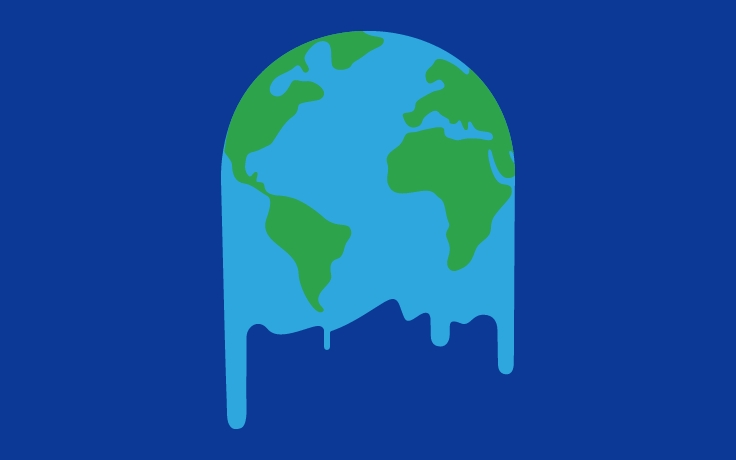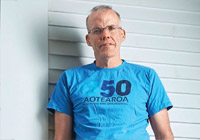ON DEC. 4, 2017, A FIRE broke out in the mountains near the city of Santa Paula, in Ventura County. Propelled by heavy winds and thick brush that had not burned in decades, the blaze spread quickly. Called the Thomas fire, it displaced tens of thousands of people and charred 280,000 acres. At the time, it was the worst wildfire in California history.
Then, in early January, rains fell — hard and fast. Mountainsides, newly devoid of vegetation, produced devastating mudslides. Montecito was slammed by a river of debris. The storm’s suddenness and ferocity meant some evacuation alerts came too late. Twenty-three people died. They ranged in age from 3 to 89.
Much of the world interpreted the fire-then-rain disaster as a tragic but unfortunate coincidence. Yet for Daniel Swain, a climate scientist working out of the UCLA Institute of Environment & Sustainability (IoES), the double-barreled devastation was something else: a harbinger of what is to come — indeed, what already is here — in the western United States.
Be afraid.
Fear can be harmful: It can propel policymakers to overreact and can lead to individuals or groups being blamed or demonized for events over which they have no control. Fear of immigrants has led to internment and the construction of a “border wall.” Fear of infection distracted from sound responses to COVID-19, especially in the early stages of the virus.
But sometimes fear is valuable — and necessary. And in the case of Swain’s research, the role of anxiety is as helpful as it is clear: Shrugging off long-standing shifts in temperature and weather patterns is foolish. But concern, created by an awareness of his findings, might motivate preparation.
When it comes to climate change, it is all too easy to look at incremental increases in temperatures and think that the risk is remote or minuscule: In fact, it is real and upon us now. People should be afraid, and they should be afraid not just for the future but for the present.
CLIMATE CHANGE IS PRODUCING increasingly long and more destructive wildfire seasons, as California has experienced. A paper Swain and five other researchers published in April in the journal Science Advances warns of a related effect: As the Earth warms, there also will be more instances of extreme rainfall, leading to major flooding. The paper finds that by the end of the century, 90% of extreme wildfires in California, Colorado and the Pacific Northwest will be followed within five years by at least three nearby extreme rainfall events — the precise conditions that ravaged Montecito.
There is an even more dramatic threat, according to Swain, who in addition to his duties at UCLA is a research fellow with the National Center for Atmosphere Research (NCAR), and the California Climate Fellow with the Nature Conservancy. In August, again in Science Advances, he and Xingying Huang published a paper with a harrowing title: “Climate Change Is Increasing the Risk of a California Megaflood.”
The paper springboards off a largely forgotten event: the “Great Flood of 1862,” in which a weeks-long series of winter storms inundated parts of (now heavily populated) Los Angeles and Orange counties. The report details how the flood created a temporary, nearly 300-mile-long lake in the interior Sacramento and San Joaquin valleys.
The researchers used supercomputers and high-tech weather modeling and found that, due to climate change, the likelihood of such an event, known as an ArkStorm, has doubled, and that it could displace millions of Californians and create more than $1 trillion in economic losses. Even if this does not happen, the paper states that by the end of the century, storms will generate 200% to 400% more runoff in the Sierra Nevada Mountains, partly because warming temperatures will cause more precipitation to fall as rain instead of snow.
The growing potential of cataclysmic fires to be followed by torrential downpours — storms that create biblical flooding — is for most people a new and unsettling facet of the climate crisis. When I asked Swain in a telephone interview if this makes climate change something we should be even more fearful of, he gave a thoughtful, layered response. He noted that climate scientists can be dismissed as “alarmists” for describing unlikely scenarios, but he also posited that some scientists seek to avoid exaggeration to the point that they might understate risks. He described how people can have difficulty differentiating between events with low probability and those with low consequences.
“As someone who deals with extreme weather and climate change, in my headspace is this realm of relatively low-likelihood but extremely high-consequence events,” Swain said. “These are events that probably won’t happen in the immediate future, but if they did, they could be catastrophic, without any exaggeration. People don’t like to think about that.”
SWAIN HAS CARVED A NICHE in the academic and atmospheric realms, one where what he terms “public-facing science communication” is nearly as important as research. This manifests in multiple forms: Swain has 72,000 Twitter followers and runs a blog called Weather West. He does hundreds of media interviews a year, including about 60 in the 10 days after the “Megafloods” paper hit. He’s quick to credit UCLA and the IoES for allowing him this pursuit.
Others in the field know how important such communication is.
“He extends his impact far beyond the realm of scientific research,” said James Done, director of the Capacity Center for Climate and Weather Extremes at NCAR. “He’s completely comfortable and very effective at communicating science to non-scientists. This is a very rare skill.”
Done, who specializes in researching tropical cyclones, has known Swain for about four years (they also have worked together). Done regularly meets with managers of water districts across the Western United States. He said he hears them mention things they picked up from Swain’s work.
Swain, he added, also is willing to cut against the grain.
“I like the way he challenges scientific consensus that has been based on the climate that we have experienced to date and may no longer be true going forward,” Done said. “He doesn’t just accept things. He thinks with great clarity and is a very fast thinker, and brings concepts together in ways I haven’t seen other people do.”
These are all important accomplishments for Swain, who grew up in San Rafael, Calif. He was fascinated with weather from a young age, and for a time wanted to be a forecaster. He describes a 1995 storm when “trees snapped in half” as a formative event. “In high school, I jumped through hoops to put a weather station up on my parents’ roof,” he said. “It’s still there.”
He earned a degree in atmospheric science from the University of California at Davis and attained his Ph.D. at Stanford. He started postdoc studies at UCLA in 2016 and has been employed there since 2018. He works “permanently remotely,” based in Boulder, Colo., where NCAR is headquartered.
“There’s a lot of extreme weather here,” he said, with what sounded like glee. “Every once in a while, if I have a slow afternoon, I go out and go storm chasing, and see if I can see a tornado from a safe distance.” The “Megafloods” paper earned global attention. USA Today and CNN covered it, as did the Guardian and The Washington Post. The New York Times turned it into an extended, interactive graphic visualization tracking a California megastorm over 30 days. “Megafloods” was just a start. Swain has a three-phase project underway: ArkStorm 2.0, involving
NCAR, University of California campuses, the Desert Research Institute and other partners. The second phase, Swain said, will include hydrology and examine what areas would get flooded and how deeply if an ArkStorm hits. A variety of state water agencies are participating.
“The third phase is to tie it all together, which is tabletop exercises, disaster-response scenarios, working with federal, state and local partners,” he said. “Where are the weaknesses today? If this happened next year, what would fall apart? What would be OK?”
The goal, he said, is to make people recognize the potential impact of a megaflood — yes, even during a drought — and start taking preventative steps, such as shoring up flood defenses and restoring floodplains.
Swain understands how the low likelihood of a megaflood in any specific year can make people less prone to focus resources on it. But he notes the dire potential, and points out that the Great Flood of 1862 occurred long before people started discussing climate change. Many parts of California were barely populated then. But now, 160 years later, the dangers are evident.
“There needs to be a significant amount of political and financial buy-in if we want to mitigate these risks,” Swain said. “I’m confident we can mitigate them to a certain degree, but it isn’t going to happen on its own. That’s why studies talking about potentially scary events can be important — not to overwhelm people or exaggerate anything, but to be honest about what the risks actually are, in hopes that we can improve our societal resilience to them.
“Our goal is not to scare people for the sake of scaring people,” he said. “Our goal is to be honest with people about potentially bad outcomes so we can make them less bad.”

























